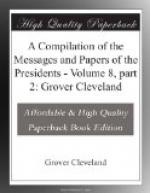Note IV.
The point originally chosen by the commissioners in 1798 as the source of the St. Croix was to all appearance the act of an umpire who wished to reconcile two contending claims by giving to each party about half the matter in dispute. No one who compares Mitchell’s map with that of Messrs. Featherstonhaugh and Mudge can fail to recognize in the St. Croix of the former the Magaguadavic of the latter. That this was the St. Croix intended by the framers of the treaty of 1783 was maintained, and, it may be safely asserted, proved on the American side. On the other hand, it was ascertained that the river called St. Croix by De Monts was the Schoodiac; and the agent of Great Britain insisted that the letter of the instrument was to be received as the only evidence, no matter what might have been the intentions of the framers. The American argument rested on the equity of the case, the British on the strict legal interpretation of the document. The commissioners were divided in opinion, each espousing the cause of his country. In this position of things the umpire provided for in the treaty of 1794 was chosen, and in the United States it has always been believed unfortunately for her pretensions. A lawyer of eminence, who had reached the seat of a judge, first of a State court and then of a tribunal of the General Government, he prided himself on his freedom from the influence of feeling in his decisions. As commissioner for the settlement of the boundary between the States of New York and Vermont, he had offended the former, of which he was a native, by admitting the claim of the latter in its full extent, and it was believed




